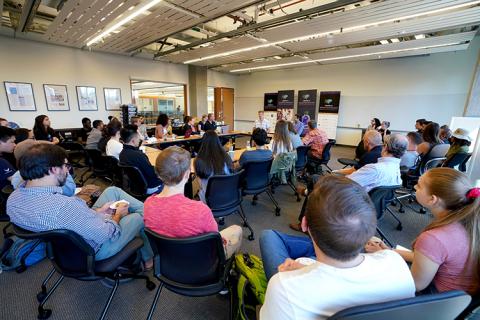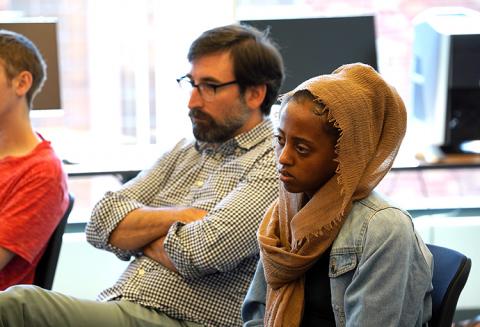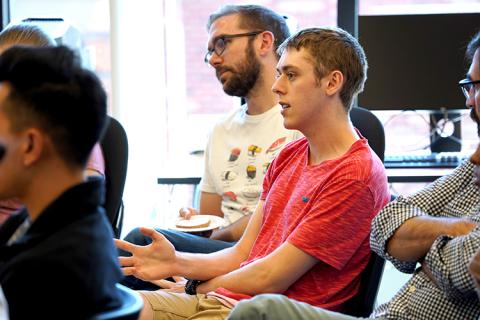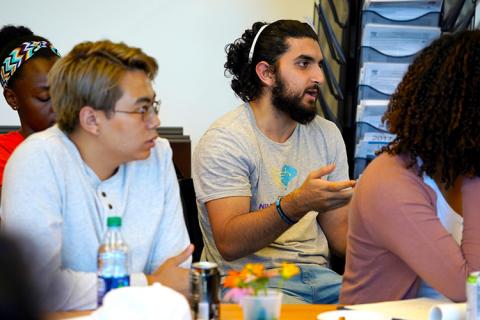The CNT Practitioner and End-user Roundtable facilitates conversations between the CNT community and neurotechnology end users. This summer’s roundtable featured Jon Schlueter, a study participant in the lab of CNT Co-Director, Chet Moritz.
Jon Schlueter has always had a passion for experiencing life to the fullest, whether it was through traveling, climbing or playing guitar. This changed in 2006 when he dove into a swimming pool and his head unexpectedly hit the bottom. This accident resulted in an incomplete cervical spinal cord injury, which left Schlueter with minimal arm and hand function, and no movement in his trunk and legs.
“Who I was a week before my injury was someone who loved my friends and spent as much time as possible climbing mountains,” Schlueter said. “I would log 80-mile hikes alone in the mountains in three days. Looking back, there was a [sense of] spontaneity and freedom that I took for granted.”
For a long time, Schlueter tried many forms of physical therapy, and he was able to regain some sensory and motor function in the first couple of years after the accident. At that rate, he thought he would be walking again in five years. However, he eventually hit a wall.
“I would meditate and envision myself hiking [and] re-visit all the peaks I'd been to when I wasn't at physical therapy,” Schlueter said.
13 years later, he was elated to participate in a four-month clinical trial at the lab of Center for Neurotechnology (CNT) Co-Director, Chet Moritz, particularly because human trials for spinal cord injury research are so rare. During the trial, Schlueter received transcutaneous electrical stimulation of his spinal cord, working closely with CNT graduate student research assistant, Dr. Fatma Inanici. This therapeutic approach uses a high-frequency waveform, paired with physical therapy, to activate the spinal cord and accompanying nerves. Above all, this procedure was non-invasive, which was an important criterion for Schlueter. After the treatment, he achieved a lasting increase in strength and dexterity in his hands.
“Each vertebra [spinal level] that can be strengthened unlocks a new level of independence,” Schlueter said.
Schlueter shared this story and the impact of his clinical trial at the CNT’s Practitioner and End-User Roundtable, an event that facilitates conversations between the CNT community and end users of neural engineering technology such as brain-computer interfaces and deep brain stimulators.
“In a center like ours, it’s important to remember that our work is about helping people who have their own concerns, struggles and reasons for adopting certain types of technology and not others,” said Scott Bellman, the associate director of diversity at the CNT.
Regaining a sense of hope – and a love for playing guitar
After participating in the clinical trial, Schlueter regained enough dexterity to play guitar for several hours a day.
“I basically pretended I was scaling mountains as I tried over and over … as I fumbled with child development toys, shapes and blocks,” Schlueter said. “We identified latent muscles and were able to induce a few new movements in my right hand [even] with physical therapy alone.”
Schlueter hopes that researchers recognize the value of incremental growth in sensory and motor function.
“I value each level of return,” Schlueter said. “The prize is not being able to run an eight-minute mile. There’s a lot of [small functional gains] along the way.”
During the event, the floor was open for people to ask questions. Attendees inquired about Schlueter ’s choice to participate in a clinical trial that used external therapy instead of an implanted device, potential drawbacks of the trial, and his level of independence after the study ended.
“It’s exciting to meet an end user and have that bigger picture of who is on the other end of this research,” said Erica Busch, an attendee and Research Experience for Undergraduates (REU) participant. “I was drawn to the [CNT’s] REU program because I was able to find so much information that gave me the big-picture perspective about where my research is going.”
One attendee asked if Schlueter had a preference for using a therapy that improved his existing sensory and motor function versus external therapies, like exoskeletons, that could provide additional support and strength. Schlueter said he could see both of these being used in tandem. Additionally, he said it was more important that neurotechnology of any kind creates a sense of autonomy for end users.
“Most people preserve a sense of dignity in accomplishing whatever they can, and trying to push that line a little further [to support their] independence,” Schlueter said.
A commitment to recovery and change in attitude
Beyond increased sensory and motor function, Schlueter has noticed a change in his attitude and perspective.
“[I’m] back to [believing that] anything is possible,” Schlueter said. “13 to 15 years ago, they would give you a window for improvement. Beyond that, returned function wasn’t promised. Now, I believe more can come.”
Attendees also asked questions of Moritz and other members of his lab. Topics ranged from the cost of the stimulation devices if they were commercially available to the importance of commitment to physical therapy after stimulation ends. In Schlueter’s case, he practiced physical therapy exercises outside of his stimulation sessions, and he received a lot of support from his family. Moritz said that Schlueter’s participation in the clinical trial highlighted the importance of sustained physical therapy, which contributed to his increase in physical function.
“Jon has helped us realize the importance of practice and motivation,” Moritz said. “We’ve started to talk about designing home therapy programs for people who may not be as extrinsically motivated or supported at home, so they can continue to get those hours of practice,”
Chris Calvin, a Research Experience for Teachers participant, said the roundtable was a way to learn about the needs of neurotechnology end users, which is an integral part of the research process at the CNT.
“As educators, we have ideas of what people want that may not align with what they want,” Calvin said. “It’s good to hear from someone on the receiving end. That’s where defining the need [for the assistive neural device] should come from.”
During the roundtable, attendees expressed gratitude for opportunities to learn from neurotechnology end users like Schlueter. Moritz and Bellman both highlighted that the CNT is committed to integrating the needs and desires of end users into neurotechnology research and development at the center.
“The center is appreciative that people are willing to share their stories with us,” Bellman said. “Their perspective is invaluable, and we are incredibly fortunate that people like Schlueter are willing to spend some time with us to talk about the research and the goals, mission and culture of the center.”
The Center for Neurotechnology is currently recruiting additional participants for this study. Follow this link for more information. Read more about a previous roundtable featuring Todd Stabelfeldt, also known as the “Quadfather,” here. You can also learn more about the Practitioner and End-User Roundtable by contacting Scott Bellman.







